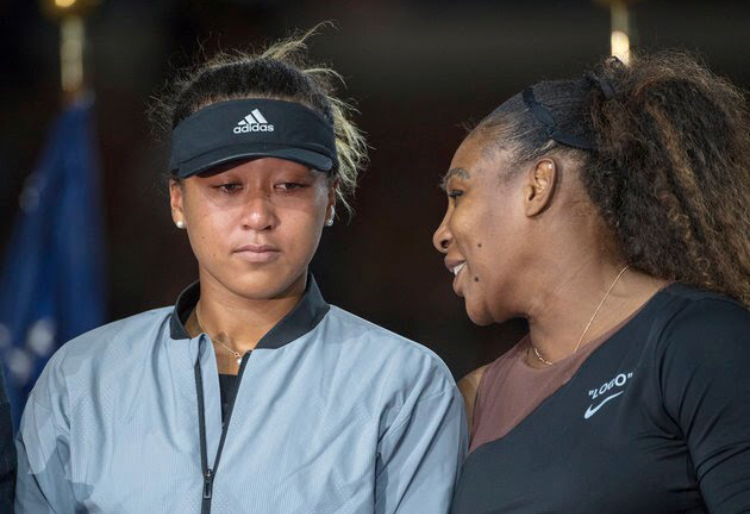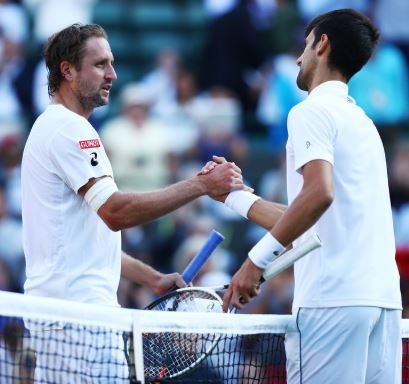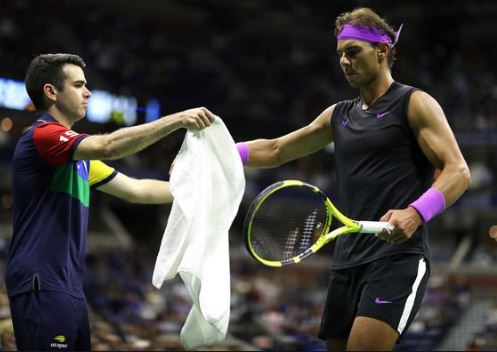There’s an old saying, “never meet your heroes, they will only disappoint you.” For Naomi Osaka, this discovery hopefully arrived in tandem with the realization that her athleticism, powerful groundstrokes and dominating serve have eclipsed a living legend, her idol, the most fearsome competitor in women’s tennis.
The fallout from the US Open women’s final has dominated tennis coverage and crossed over to the mainstream media. Since I was interviewed about it on the local New York evening news (and they used about 10 seconds of my interview), I want to publish my full take on what happened in Flushing on Saturday and how tennis should move forward. If you follow me on Twitter, you’ve already had a taste.

Unless you live under a rock, you know by now that there was a bit of drama that tainted the last few games of the women’s final and sullied the arrival of Naomi Osaka as the next great champion of women’s tennis. The drama, no surprise, came from Serena Williams, on the losing end of her second major final this summer- an impressive summer by anyone’s standards, returning to the tour from childbirth and associated health complications.
Serena was issued three code violations over the course of the match. #1 a code warning for coaching (which is allowed on the WTA tour, but, not at the 4 major tournaments). #2 a point penalty for smashing her racquet. #3 a game penalty for verbal abuse of the umpire (which brought Osaka a game away from sealing the second set and the match).
As I said on the newscast, the tirade and the racquet smashing, while sadly par for the course on tour, were completely unacceptable. Serena has to take full responsibility for her behavior in this regard. From a strategic standpoint, a deserving champion keeps composure and demonstrates cognizance of the situation upon receiving a code violation (justified or not). Serena’s legacy is pocked with ugly incidents like this one. Her 2009 US Open meltdown cost her a semifinal match against Kim Clijsters for threatening a line judge and receiving multiple code violations. So there is a history of Serena losing her composure under pressure at the US Open, which I’m sure loses her any sympathy in the eyes of casual tennis observers.
That said, there is plenty of shame to go around for Saturday’s ugly spectacle. In no particular order of culpability:
Serena’s coach and former boyfriend, Patrick Mouratoglou, admitted on live television that he was attempting to coach Serena with hand signals that were shown on the broadcast. He defended his actions, saying every other coach is doing the same, including Osaka’s coach and Rafael Nadal’s uncle, Toni. Just because her coach has the judgement of… well, a French playboy, doesn’t mean Serena received the coaching. In fact, she probably didn’t. A mostly insightful Martina Navratilova points out it doesn’t matter. While the penalty is assessed to the player, the offending party is the coach. Martina may not have read the rule on page 44 of the ITF Grand Slam Rulebook (emphasis added):
“Players shall not receive coaching during a match (including the warm-up). Communications of any kind, audible or visible, between a player and a coach may be construed as coaching.”
I think this explains, in part, Serena’s ultra defensive reaction. In her correct understanding of the rulebook text, Ramos misinterpreted the rule. She has to receive the coaching for there to be a penalty. However, there is a standard interpretation among officials that says if a coach is making hand signals, they are being received. Either way, her coach has shown remarkably bad judgement over the years and this episode underscores that truth.
Serena has felt targeted at the US Open dating back, before video replay was used on court, to a match with Jennifer Capriati where she was blatantly cheated by an officiating crew on a series of bad line calls. Serena’s indignant reaction to the coaching violation reminds me of her reaction to the excessive drug testing she was submitted to earlier this year. I wrote a post on Serena’s faulty logic (and hopeful legacy) on that very topic just before Wimbledon. Jonathan Liew in The Independent does a much better job placing us in Serena’s shoes than I ever could. Suffice it to say, while Serena has the baggage of meltdowns at the US Open, she also carries the baggage of being treated unfairly. I’m no psychoanalyst, but, hearing her scream “You’re a thief. You stole a point from me.” raises the question, which match is she talking about?
Beyond Serena and her coach, one has to look at the behavior of the chair umpire, Carlos Ramos. Though the ITF issued a days late statement of support for Mr. Ramos’ acting “in accordance with the relevant rules,” the WTA and USTA have shown their disapproval by releasing statements that do not back him. Much of the criticism, including my own on Twitter, has centered on Mr. Ramos’ lack of discretion in assessing code violation #1 and code violation #3. As Martina points out in her piece, it is common for chair umpires to communicate with a player about a coaching violation with a “soft warning” before issuing a code violation. This gives the player a chance to reign in a coach whose actions can have consequences for them on court. Leaving aside Ramos’ misinterpretation of the coaching rule, had Mr. Ramos shown better discretion by issuing a soft warning, we might actually be discussing Naomi Osaka and another strong tournament for Serena. Mr. Ramos has a history of rigidity, absurd rulings, poor communication and inciting players, including a coaching violation called against Venus Williams in 2016. Which begs the question, why was he on court for a US Open final with one of the most easily triggered players on the planet? He seems debilitatingly “by the book” where other umpires, Alison Hughes for example, seem to understand the discretion and communication necessary to handle the job.
While the coaching violation got Serena’s back up (beyond anything normal), the third code violation, for verbal abuse, while deserved, was an opportunity for Serena, and a women’s movement that could do without her, to make a fairly strong argument about a double standard in assessing penalties to women as compared to their male counterparts. It should first be noted that the number of code violations issued throughout the 2018 US Open was heavily weighted toward the men, 86-22. That said, Serena, Billie Jean King and everyone who came to Serena’s defense on code #3 have a legitimate argument that there is a much lower threshold for assessing code violations to women for verbal abuse, while the men (who behave worse across the board) get away with far more. As Jimmy Connors once called an ump “an abortion” without consequence, it doesn’t take a minute on YouTube to find incidents of Saint Federer, Nick Kyrgios or Novak Djokovic cursing out officials without repercussion. In a tournament where a chair umpire provided Kyrgios a pep talk to try harder, it is a stark contrast to see a lack of communication and rigidity from Ramos in dealing with Serena. Andy Roddick, no stranger to umpire abuse, was one of the first to recognize this.
Though her reactions yet again crossed the line, if there’s anything Serena understands well it is injustice. She has experienced racism and sexism from before she was equipped to handle it. Her father had a way of handling it, which has been both celebrated and derided. One of the ugliest parts of this sad affair is the reemergence of racist tropes in cartoons online. The big question facing tennis today is how do we all move forward?
First of all, the no coaching rule has to go. Banning coaching, but, putting coaches in first row corner seats, visible across the court from players, visible from the players’ benches, and within earshot when a player is on the same side, is hypocrisy so laughable there’s no wonder Mouratoglou can’t restrain himself from coaching or admitting it. Since the WTA now allows coaching, it’s time to expand coaching opportunities to all of professional tennis. Billie Jean King wants coaching allowed between every point, like college tennis or World Team Tennis. I tend to think changeovers are the appropriate time, but, I can also point to several successful instances helping my players with strategy right before an important point. Notwithstanding, just because a player receives coaching does not mean he or she is capable of executing it. As any coach can tell you, coaching in-game often does more harm than good. There are studies that show in-game coaching, across all sports, is far less useful than analysis and strategy developed over an extended period of training. Still, managed successfully, in-game coaching might make the sport more interesting to watch as strategic adjustments are made and countered.
Second lesson, officials need to be great communicators. With officials now threatening to boycott Serena’s matches (just her? not any of the men??), the ITF should include better communication training in its development of chair umpires. An umpire like Ramos, with 40 years of experience, has to be better at communicating with players. Obviously, having a pep talk is too far. But, demonstrating discretion and establishing lines of communication should be basic skills for umpires. Generally speaking, the work from the chair at this year’s tournament was a distraction and that’s when you know the standards have fallen. I can’t believe I’m about to hold up an NFL officiating crew as example, but, during the Bears/Packers game on Sunday night, textbook holding on a Bears lineman went uncalled. The result of the play was not beneficial to the Bears. They had to punt. A little discretion (I think it was discretion, not incompetence) made the game better for everyone.
Lastly, Serena needs to get some help. Whether that is adding a sports psychologist to her team or removing a coach that has failed to help her grow in the important areas of managing pressure and maintaining composure (dating her instead), change is needed.
We’re all on personal journeys of growth. Serena’s journey has played out in public from a very young age. I hope emerging American superstars Caty McNally and Coco Gauff are watching and learning from the mistakes Serena has made. I also hope the sport has evolved by the time they are on tour to prevent the sad spectacle we saw on Saturday.
A final thought on Naomi Osaka: Why does the media insist she is Japanese without any mention that she has been in the U.S. since she was 3, doesn’t speak Japanese, and is half Haitian? Why is her biracial identity too much to describe succinctly? Why isn’t she Haiti’s first major winner? Could it be that Haiti was included in a certain list of [favorite vacation spots]?
– Jeff Menaker
Follow me on Twitter




